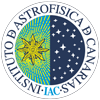Jorge Casares Velázquez

Dates of the visit: 21/07/2014 to 18/08/2014. ![]()
Research line: Stellar and Interstellar Physics
Institution visited: University of Oxford (United Kingdom).
Dr. Casares collaborates with Profs. R. Fender, P. Podsiadlowski and Dr. T. Muñoz-Darias on the study of accreting compact stars in interacting binaries. Some of the results have been published in the Monthly Notices of the Royal Astronomical Society (MNRAS).
Currently Dr. Casares is a staff researcher at the IAC.
His main research interests are the detection of stellar-mass black holes and the determination of fundamental parameters in their host X-ray binaries. Black holes are usually detected through dramatic accretion episodes (powering bright X-ray outbursts) but can be only confirmed when the outburst subsides and dynamical studies of the faint companion star become feasible. At present he is trying to devise new strategies to unveil quiescent black holes. These make up the bulk of the Galactic population as predicted by population synthesis models and suggested by 4 decades of discoveries.
The specific objectives of the visit to the University of Oxford are:
1) Characterize the X-ray and radio emission of the extreme inclination black hole binary Swift J1357.2 -0933 in quiescence (results published by MNRAS).
2) Model the evolutionary history and fate of the first Be/black-hole binary using Binary Population Synthesis models (results published in MNRAS).
3) Analysis of near-infrared spectra of the prototypical X-ray Binary Sco X-1 and constraints to the masses of the stellar components (results published by MNRAS).
In addition, J. Casares worked on the detection of a correlation between the FWHM of the Halpha line and the velocity of the companion star in black hole transients (Casares 2015, published in ApJ).


